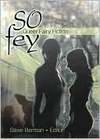 So Fey: Queer Fairy Fiction
So Fey: Queer Fairy Fiction
Edited by by Steve Berman
Haworth Positronic Press, 370 pages
ISBN-13: 978-1560235903
Reviewed by Steven LaVigne
In his masterpiece, Peter Pan, Sir J. M. Barrie tells us that “Every time a child says, “I don’t believe in fairies, somewhere a fairy falls down dead.” Fortunately, I do believe in fairies and so do the 22 authors who contributed to So Fey.
This is an outstanding collection, because without a direct chronology, the reader time trips from modern times with the hero of Tom Cardamone’s “A Faun’s Tale,” who discovers the pleasures held within Central Park’s Rambles, to Delia Sherman‘s medieval “The Faerie Cony-Catcher,” as the queen of Elfland (borrowed from Purcell’s Faerie Queen) and her handmaiden lead their prey, a smith, into gay sexual fulfillment. The queen of Elfland makes another appearance in Sarah Monette’s “Three Letters from the Queen of Elfland,” as a young wife is drawn to the queen, in spite of her husband’s pleading to stay with him.
Three tales focus on tragic love with objects from nature: Danny finds a tragic love with his perfect man in Kenneth D. Woods’ “The King of Oak and Holly;” a monk is fascinated by Craig Laurance Gidney’s “A Bird of Ice,” and an Asian princess discovers love in the Tolkien-like, “Year of the Fox” by Eugie Foster.
Some of the pieces collected here are drawn from or are renovated versions of classic literature. The myth of Orpheus and Euridice is used by Holly Black for “Coat of Stars as Rafael,” a young gay dancer, Rafael, returning to his hometown and visiting a strange underworld where he makes a bargain to reconnect with his deceased love. Laurie J. Marks’ “How the Ocean Loved Margie” borrows from the same Celtic tale which John Sayles used in his film, “The Secret of Roan Inish.”
Two stories toward the end of the volume held special interest for me. Because I recently completed the first volume of His Dark Materials, The Golden Compass, I loved Lynne Jamneck’s “How Laura Left a Rotten Apple and Came Not to Regret the Cold of the Yukon.” Told in first person, Laura leaves Manhattan for a place called Poniwok. There, she finds herself attracted to Gwen, the town’s police sergeant. At first rejecting her friendship, Laura finds herself fascinated by the woman who shows her the Northern lights.
Borrowing the names of Jane, George and Michael from P.L. Travers, Joshua Lewis was inspired by the aforementioned J. M. Barrie in his lovely piece, “Ever So Much More Than Twenty” (the words Wendy uses tell Peter Pan that she’s no longer a child). In this enchanting story, Michael’s daughter, Jane, recommends that they return to the cabin of her father’s childhood. It was in the magical woods that both Jane and Michael encounter the joys of his youth, as they both encounter a fairy who is every bit a modern incarnation of Barrie’s most famous hero.
A sublime experience for any gay reader, So Fey has 22 remarkable stories you’ll return to on a frequent basis, and if you don’t already, will have you believing, once and for all, in fairies!
This is just an excerpt from this issue of White Crane. We are a reader-supported journaland need you to subscribe to keep this conversation going. So to read more from this wonderful issue SUBSCRIBE to White Crane. Thanks!
Aside from his role as a regular contributor and reviewer for White Crane, Steven LaVigne is also a teacher, playwright, reviewer and director who lives in the Twin Cities. His work appears regularly online and he frequently adapts literature for children’s theatre. His most recent play, based on the Arabian Nights, was presented this past summer. He’s presently doing research for a new project.